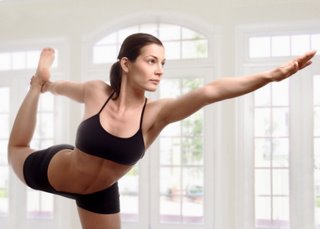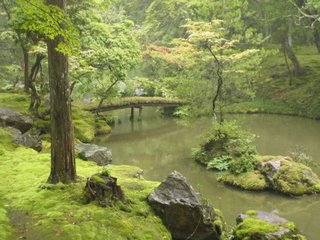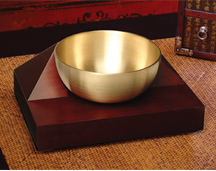
Winter Yoga
For winter sports fans, yoga offers refined technique, better balance, and the freedom to fly.
When Hannah Dewey skis, she likes to go fast. “I tend to powerhouse it,” she says. “I muscle my way through.” As a longtime skier and a professional wildfire fighter, Hannah is strong enough to ski fast, even uphill. But after 22 years of skiing, she’s learned something surprising, a lesson that comes from her yoga practice: To get the most power, she has to slow down and focus her mind on the present moment. “If I go calmly step by step, concentrating on my form, I can actually go faster,” she says.
I met Hannah, along with more than 40 other skiers, at the eighth annual Women’s Ski and Yoga Retreat in the Methow Valley of northern Washington. I joined a group of athletes who do yoga for many reasons: to enhance their performance on skis, to ward off injury, and to experience the singular bliss that comes from a focused effort and a clear mind. “Yoga and skiing go together for me,” says Mary Ellen Stone, another retreat regular. “They’re both ways of putting away all the clutter in our lives and focusing physically, emotionally, and technically on something that’s not easy to do. But when it all comes together, it’s one of the best feelings in the world.”
I’d come to have my own experience of the synergy of yoga and skiing, but because I hadn’t skied since
I was a kid, getting faster was not my primary goal. Still, the lessons I’d internalized in my years of yoga practice turned out to serve me well on the trails.
Let It Snow
The secluded Methow Valley is a Nordic skier’s paradise. A popular place for Olympic skiers to train,
the valley has 120 miles of cross-country trails—one of the longest systems of groomed trails anywhere
in North America—as well as access to many more miles of challenging backcountry ski routes in the 4 million acres of the surrounding Okanogan-Wenatchee National Forest.
The women meet at Sun Mountain Lodge, the mountaintop resort hosting the retreat, which
is organized by the nearby Winthrop Fitness center. Many of my fellow retreat participants have skied competitively. Some are experts at downhill skiing but have come to master cross-country. A few are snow-sport newbies like me.
At 7 o’clock the next morning, I warm up my resistant quadriceps in Melanie Whittaker’s yoga class. Melanie is a cross-country skier and the yoga director for Winthrop Fitness, and has been practicing yoga for more than 30 years. She teaches an Iyengar-inspired style and counts elite skiers and other athletes among her students. She explains that we’re preparing ourselves to move forward with agility and speed while balancing on a slippery and constantly changing surface of snow and ice. For the next 90 minutes, she leads us through a series of strong
poses like Ardha Chandrasana (Half Moon Pose) and Virabhadrasana (Warrior Pose) I, II, and III, which call for strength, balance, and confidence—the same qualities we’ll need
to draw on once we strap on our skis.
Moving with any sort of grace on a slippery surface is inherently challenging, she tells us,
as we do Utkatasana (Chair Pose), and to keep our balance we’ll need a strong, compact form and a low center of gravity. She also reminds
us that to be successful at skiing, as with yoga, we have to learn to trust our bodies. When we do Handstand, she reminds us that it is trust that allows us to bring our hips over our heads, and our legs into the air. I’ll have occasion to remember her words later in the day.
Free Fall
After class I make my way, skis in hand, to a flat, groomed field for my beginner’s lesson.
A misty fog floats across the hills, just above the treetops, and occasional watery sunshine glints from behind the clouds.
The two most common kinds of cross country skis—classic and skate—have corresponding, but different, techniques. To move forward on classic skis, you keep your feet
parallel and execute a series of gliding lunges. With each step, you shift your center of gravity forward, bringing your body weight fully over the ball of the front foot, almost past the point where you feel you’re going to fall, while pushing the ground away with your back leg. To
balance and stay stable, says my instructor, you tuck into an Utkatasana-like form, bending your front knee and ankle, dropping your sitting bones, and firming your core.
When I ask some of the more experienced skiers, like Hannah, how their yoga practice supports their skiing, they emphasize core strength and balance. “In skiing, my form comes from my core,” says Hannah. “I concentrate on keeping my core really tight, and my legs just follow.” As the ski class gets under way, I see what she means. If I bend my ankles and knees and tip my weight forward, I glide. If I straighten up out of that slight tuck, I
wobble and, more often than not, fall.
“Bend your knees and ankles,” shouts my instructor. “Weight forward!” I bend my knees. I bend my ankles. I drop my sitting bones, finding the skier’s Utkatasana. I connect to the strength in my ankles, calves, and thighs and, with a slight adjustment, release my body weight forward. And there it is. I am gliding with a remarkable feeling of ease, making wide turns down the slope. I no longer feel that the skis are unruly clown shoes, tripping me up. They are seamless extensions of my legs, and they do my bidding.
That afternoon, we take off down a trail into the forest. I experience a delicious sense of well-being and freedom as I slide through the quiet forest and enjoy the afternoon sunlight gleaming through pine trees decked with garlands of sage-green moss. I’ll never look at Utkatasana the same way after today. Instead of feeling like a sweaty struggle for balance, it now feels like the pose of victory.

Moss Garden
Restore and Tend
That evening, the group meets for an apres-ski stretch, and I find Melanie for a quick consultation. All of that forward crouching has left me with a sore back. She has me try a variation of Sphinx Pose, in which I press my hands into the ground and work my upper arms toward each other to open up my upper back and chest. A supine twist relieves my lower back, and Supta Baddha Konasana (Reclining Bound Angle Pose) helps release the piriformis, a muscle deep in the buttocks that tends to tighten in skiing.
As to my other aches and pains—I’m feeling my shoulders, arms, core, inner thighs, outer thighs, calves, and ankles—she tells me I’m making the rookie mistake of unnecessarily gripping a lot of auxiliary muscles I don’t need to in the process of trying to engage the ones I do. “You’ll get more power and control when you learn to isolate the muscle groups you need,” she says. “You’ll also be a lot less sore and fatigued at the end of the day. Practicing the body awareness you learn in yoga will help you on the slopes.”
Being Balance
In the next morning’s yoga class, Melanie brings our attention to our feet. Being aware of our feet, she tells us, is a critical factor in balance. In Utthita Parsvakonasana (Extended Side Angle Pose), we practice putting even pressure through the entire foot, observing how the slightest shift to one side can unbalance us.
The skiing portion of the second day focuses on skate-style skiing. Skate skis are especially slippery. When you are moving across the snow’s slick surface, the slightest muscular effort creates motion, which presents a new kind of balancing challenge. To gain control of my movement, says my instructor, I have to master the art of “edging,” or delicately shifting weight to the inner edge of my foot to grip into the snow, which will allow me to push off into a glide.
As I slide around like a bumper car, I try to remember to spread my toes and keep my feet relaxed so that I can control how my weight shifts. Meanwhile, I’m fielding more instructions: Bend your knees, push off the back foot, shift weight to the front foot, bring one pole forward. Every time I try to do one thing the instructor tells us, I forget the others, tense up, and lose my balance. Finally she notices my difficulty and gives me yet another instruction: “You—just stop thinking!”
I pry my gaze away from my feet, look straight ahead in the direction I want to go, and thrust myself forward into a glide. I plunge forward, and this time I start to get the momentum, the slight swaying, the powerful back-leg strokes pushing me forward. I grin like a little kid, glancing at the teacher to make sure she sees me before my next slippery fall.
And then it occurs to me: Balance is not something you achieve and hold on to. It’s more ephemeral; it’s a string of temporary successes, held momentarily, lost, and then discovered again. Skiing gives you a fleeting experience of balance with each shift of weight and each glide. But it’s not permanent. When you lose it, you just have to have faith that you’ll come back to it.
Sweet Surrender
I feel I’ve been treated to a glimpse of the synergies of yoga and skiing. Hannah told me that her favorite yoga teacher reminds her to slow down and stay focused when she starts to rush through her Sun Salutations. Of all the benefits that her practice confers on her sport, she says, the most important one has come in the form of a mental shift: “Yoga has helped me slow down and concentrate on myself, and on having a good time out there.”
Mary Ellen echoes this sentiment: “When you’re out there and you see the snow sparkling on the trees and hear the ravens calling, you think, ‘I’m so lucky, so extraordinarily lucky, to be doing this.’ It’s a deep feeling, being there, right in that moment. That feeling is hard to come by.”
After dinner on the last night of the retreat, I make for the hot tub. I set my chin on the cold rock ledge of the tub and count a handful of lights in the houses in the valley below. The rest of my view consists of the snow-blanketed Mount Gardner. The full moon shines through the spreading branches of a pine tree on the slope before me. A rumbling sound disturbs the quiet as the trail grooming machine starts up. To my ears, it’s a sweet sound, promising freshly groomed trails to glide down in the morning.

Timers for Yoga and Meditation with Tibetan Singing Bowl
Use our unique “Zen Clock” which functions as a Yoga Timer. It features a long-resonating acoustic chime that brings your meditation or yoga session to a gradual close, preserving the environment of stillness while also acting as an effective time signal. Our Yoga Timer & Clock can be programmed to chime at the end of the meditation or yoga session or periodically throughout the session as a kind of sonic yantra. The beauty and functionality of the Zen Clock/Timer makes it a meditation tool that can actually help you “make time” for meditation in your life. Bring yourself back to balance.

Meditation timers and chime clocks by Now & Zen, Inc.
Now & Zen’s Yoga Timer Shop
1638 Pearl St.
Boulder, CO 80302
(800) 779-6383
Adapted from Yoga Journal.com, By Carmel Wroth, sequence by Melanie Whittaker.
Posted in Well-being, yoga, Yoga Timer, Yoga Timers by Now & Zen